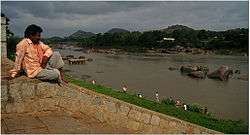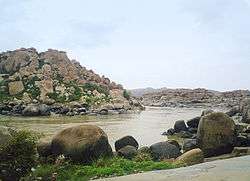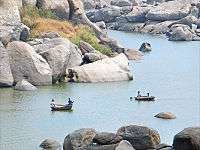Tungabhadra River
| Tungabhadra River (ತುಂಗಭದ್ರ ನದಿ) | |
 Tungabhadra River at Hampi | |
| Country | India |
|---|---|
| States | Karnataka, Andhra Pradesh, Telangana |
| Tributaries | |
| - left | Tunga River, Kumudvati River, Varada River |
| - right | Bhadra River, Vedavathi River, Handri River |
| Cities | Harihar, Hospet, Hampi, Mantralayam, Kurnool |
| Source | Koodli (place where the Thunga and Bhadra rivers meet |
| - location | Koodli, Bhadravathi, Karnataka, India |
| - elevation | 610 m (2,001 ft) |
| - coordinates | 14°0′30″N 75°40′27″E / 14.00833°N 75.67417°E |
| Mouth | Krishna River |
| - location | Alampur, Mahbubnagar, Telangana, India |
| - elevation | 264 m (866 ft) |
| - coordinates | 15°53′19″N 78°09′51″E / 15.88861°N 78.16417°ECoordinates: 15°53′19″N 78°09′51″E / 15.88861°N 78.16417°E |
| Length | 531 km (330 mi) |
| Basin | 71,417 km2 (27,574 sq mi) |
The Tungabhadra River is a river in India that starts and flows through the state of Karnataka during most of its course, before flowing along the border between Karnataka and Andhra Pradesh and ultimately joining the Krishna River along the border of Andhra Pradesh and Telangana. In the epic Ramayana, the Tungabhadra River was known by the name of Pampa.
Course

The Tungabhadra River is formed by the confluence of the Tunga River and the Bhadra River at Koodli which flow down the eastern slope of the Western Ghats in the state of Karnataka.The 2 rivers originate in Chikmagalur District of Karnataka along with the Nethravathi (west-flowing river, joining the Arabian Sea near Mangalore), the Tunga and the Bhadra rise at Gangamoola, in Varaha Parvatha in the Western Ghats at an elevation of 1198 metres. The Bhadra river flows through the industrial city Bhadravathi. More than 100 tributaries, streams, creeks, rivulets and the like contribute to the two rivers. The journey of the Tunga and the Bhadra is 147 km (91 mi) and 171 km (106 mi) respectively, till they join at Koodli, at an elevation of about 610 metres near Holehonnur, about 15 km (9.3 mi) from Shivamogga, areca granary of the country. It is a confluence of both the Dwaitha and the Adwaitha philosophies. From there, the Tungabhadra meanders through the plains to a distance of 531 km (330 mi) and mingles with the Krishna at Gondimalla, near the famous Alampur in Mahaboobnagar District of Telangana . The Varada flowing through Shimoga, Uttara Kannada and Haveri districts and Hagari in Chitradurga, Bellary district, Koppal District and Raichur Districts in Karnataka and the Handri in Kurnool distriict of A.P. are the main tributaries of the Tungabhadra. Many rivulets and streams join these tributaries.

There are many holy places all along the rivers: primarily temples of Saiva Cult on the banks of the Bhadra and all the cults on the banks of the Tunga. Sringeri, Sarada Petham established by the Adi Shankaracharya is the most famous one on the left bank of the Tunga, about 50 km (31 mi) downstream of its origin. Manthralayam Sree Raghavendra Swamy Muth in Kurnool District and Alampur in Mahaboobnagar District, Jogulamba is the presiding deity, known as Dakshina Kashi are the other important pilgrimage centres. There is a cluster of Nava Brahma temples constructed by the early Chalukyas.
An important feature of the river banks is the flood protection walls all along the rivers, constructed by Sri Krishna Devaraya between 1525 and 1527 AD. You find them wherever there is a possibility of land erosion during the floods. It starts at Sringeri and ends at Kurnool, just few kilometers from its mouth. They are stone constructions and still intact. Huge boulders of 3' x 4' x 5' are also used in its construction.
It then takes a northeasterly direction through rugged ridges formed by boulders piled on ancient granite outcroppings over the elevated plateau that dominates peninsular India, the Deccan Plateau.

Piles of granite in varying shades of grey, ochre and pink dominate the landscape. The river has cut through weaker rocky substrata of the Hampi landscape and created a narrow gorge where granite hills confine the river in a deep ravine.[1]

In this setting the ruins of Vijayanagara and Hampi, the seat of power of the Vijayanagar empire, overlook this holy river, creating a mythological landscape merging sacred traditions about a multitude of significant divinities.[2]
The granite outcrops slowly disappear as the river flows south and the land opens into a long, broad plain ending at the rising slopes of the Sandur hills, rich in iron and manganese, beyond which is the town of Hosapete. The Tungabhadra Dam was constructed at Hosapete in the middle of the 20th century to harness the river water, aiding the growth of agriculture and industry in the region.
The Tungabhadra River then flows east, joining the Krishna along the border of Andhra Pradesh and Telangana states. From here the Krishna continues east to empty into the Bay of Bengal. The wedge of land that lies north of the Tungabhadra River, between the Tungabhadra and the Krishna, is known as the Raichur Doab.
Temples

- Shringeri Sharadamba Temple is on the banks of the Tunga River in Chikmagalur District, Karnataka.
- There are a number of ancient and holy sites on the banks of the Tungabhadra River. At Harihara there is a temple dedicated to Harihareshwara. Surrounding the modern town of Hampi are the ruins of Vijayanagara, the site of the powerful Vijayanagara Empire's capital city and now a World Heritage Site. The site, including the Vijayanagara temple complex ruins, are being restored.
- Alampur, on the left northern bank of the river, known as Dakshina Kashi in Mahaboobnagar District about 25 km from Kurnool is another important place, where the early Chalukyas built a cluster of temples. The Nava Brahma Temples complex is one of the earliest models of temple architecture in India. Jogulamba is the presiding deity.
- The Moola Brindavana of Guru Raghavendra is located on the banks of the Tungabhadra at Mantralayam, Andhra Pradesh.
Dams
About 15 km upstream from Shimoga at Gajanur across the River Tunga, a dam was constructed. At Lakkavalli about 15 km upstream of Bhadravati across the Bhadra a dam was constructed. They are multipurpose dams and irrigate lands in Shimoga, Chikkamagalur, Davanagere and Haveri.

Tungabhadra Dam is across the river Tungabhadra, a tributary of River Krishna. The dam is near the town of Hosapete in Karnataka. It is considered a multipurpose dam. Its storage capacity is 135 Tmcft. Owing to siltation, the capacity has been reduced by about 30 Tmcft. If there are seasonal and late rains, the dam distributes the estimated quantity of 235 Tmcft. It is filled when water is let into the canals during the rainy season. The main architect of the dam was Thirumalai Iyengar, an engineer from Madras; a general-purpose hall was named after him. (Multipurpose dams help in generation of electricity, irrigation of land, prevention and control of floods, etc.) It has become a picnic or tourist spot over the years. Tungabhadra Dam is near heritage site Hampi.
Few miles upstream the Tungabhadra river from Mantralayam town, Interstate Rajolibanda barrage is located which supplies water for irrigation in Karnataka and Andhra Pradesh on the right bank of river.
At Sunkesula, about 25 km upstream from Kurnool, a barrage was constructed around 1860 by the British engineer, hailed as Bhagiratha for Andhras, Arthur Cotton. Originally it was intended to be used for navigation also. As the road and rail transportation increased it is now an irrigation project, for Kurnool and Kadapa districts, carrying water through the K. C. Canal (Kurnool-Cuddapah; until recently Kadapa was spelled "Cuddapah"). The barrage was replaced by the Kotla Vijayabhaskara Reddy Project, a permanent dam. It impounds about 15,000,000,000 cubic feet (0.42 km3) of water and irrigates about 300,000 acres (1,200 km2) of land in Kurnool and Kadapa districts.

Problems
Industrial pollution has damaged the Tungabhadra River. Industry and mining on its banks in the Chikkamagaluru, Shimoga, Davangere, Haveri, Bellary, Koppal and Raichcur districts of Karnataka and Kurnool in Andhra Pradesh and Mahaboobnagar in Telangana (almost all the districts along the course of the river) generate enormous amounts of effluents. According to M. Shankar, "It is disturbing to note that nearly three crores of litres of effluents were being released to the Tunga from [Shimoga] every year."[3] This is the contribution of one city which, like Bhadrvathi and HospeAt, cannot boast of being an industrial city. As such, it is one of the most polluted rivers in the country.
Downriver from the industries, the water has turned dark brown and has a pungent odour. Altogether, Tungabhadra River pollution has affected 1,000,000 people in the sub-basin as most villages used the river water, previously obtained through the ancient tank system, for drinking, bathing, irrigating crops, fishing and livestock water. The livelihood of village fishermen has been harmed by regular fish kills that have exhausted Tungabhadra's fisheries.[4]
See also
References
- ↑ "Physical landscape of Vijayanagara". Retrieved 20 September 2006.
- ↑ "Vijayanagara Site". Retrieved 18 June 2014.
- ↑ The Hindu, 6 June 2008
- ↑ "River Krishna". Retrieved 20 September 2006.
External links
| Wikimedia Commons has media related to Tungabhadra River. |